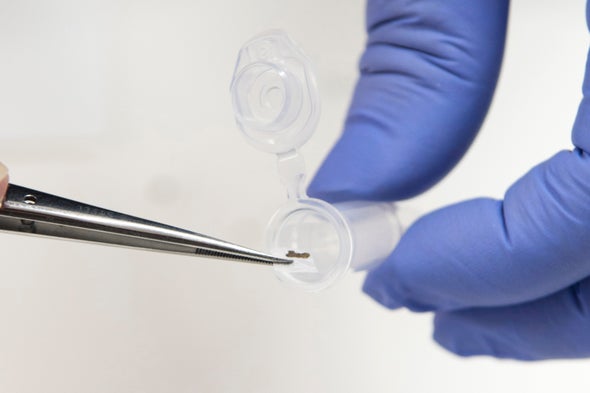(单词翻译:单击)
听力文本
Hi, I'm Scott Hershberger, with Scientific American as an American Association for the Advancement of Science Mass Media Science and Engineering Fellow. And here's a short piece from the September 2020 issue of the magazine, in the section called Advances: Dispatches from the Frontiers of Science, Technology and Medicine. The article is titled "Quick Hits," and it's a rundown of some stories from around the globe.
From Argentina:
The earliest dinosaurs laid soft-shelled eggs, paleontologists say. A new chemical analysis of a more than 200-million-year-old fossilized egg from Patagonia—and a clutch of more recent eggs from Mongolia, found in the Gobi Desert—revealed a thin film matching the characteristics of modern soft-shelled eggs.
From England:
Archaeologists found that 20 deep shafts, previously thought to be natural sinkholes and ponds, were dug by Neolithic humans. The shafts form a circle two kilometers in diameter, with the Durrington Walls monument at its center, just three kilometers from Stonehenge.
From Brazil:
Researchers documented the largest lightning bolt ever recorded. The "mega-flash," which extended for more than 700 kilometers in southern Brazil in 2018, was detected by a new advanced weather satellite in geostationary orbit.
From Israel:
Researchers sequenced DNA samples from the Dead Sea Scrolls, identifying fragments made from sheep skin and others made from cow hide. The technique could help match fragments together and unravel the artifacts' geographic origins.

From Indonesia:
Scientists identified an elusive nose-horned dragon lizard in the forests of North Sumatra. Despite appearing in the mythology of the indigenous Bataks, the visually striking species had been spotted by scientists only once before—almost 130 years ago.
And from Australia:
Submarine drones uncovered an extensive system of underwater "rivers" of dense, salty water along Australia's continental shelf. These flows carry organic matter from the coast into the deep ocean, and their volume varies seasonally, peaking in winter.
That was "Quick Hits." I'm Scott Hershberger.
参考译文
大家好,这里是《科学美国人》,我是斯科特·赫什伯格,是美国科学促进会大众传媒科学与工程研究员。下面是本杂志2020年9月刊的一篇短文,摘自“进展:科学、技术和医学前沿快报”版块。这篇文章名为《要闻快讯》,汇集了全球报道的摘要。
阿根廷:
古生物学家表示,最早的恐龙产的是软壳蛋。对巴塔哥尼亚2亿多年前化石恐龙蛋以及蒙古戈壁滩发现的一窝比较近期的恐龙蛋进行最新化学分析后,发现了一层与现代软壳蛋特征相匹配的薄膜。
英国:
考古学家发现,之前被认为是天然天坑和池塘的20个深立井,其实是新石器时代人类挖掘的。这些立井形成一个直径两公里的圆圈,杜灵顿墙纪念碑位于其中心,距离巨石阵仅三公里。
巴西:
研究人员记录了有史以来最大的闪电。这个“超级闪电”于2018年在巴西南部延伸了700多公里,由地球同步轨道上一颗最新的先进气象卫星探测到。
以色列:
研究人员对死海古卷的DNA样本进行了测序,确定了一些片段由羊皮制成,而其他片段则由牛皮制成。这项技术有助于将碎片拼在一起,并解开这一人工制品的地理起源。
印度尼西亚:
科学家在北苏门答腊的森林中发现了一种难以捕捉的鼻角龙蜥蜴。尽管曾出现在当地土著巴塔克人的神话中,但这一视觉上引人注目的物种之前只被科学家发现过一次——大约在130年前。
澳大利亚:
海底无人机在澳大利亚大陆架沿岸发现了一个巨大的地下水“河流”系统,流着的是稠密的含盐水。这些水流将有机物从海岸带到深海,其体积随季节变化,在冬季达到峰值。
以上是《要闻快讯》,我是斯科特·赫什伯格。
译文为可可英语翻译,未经授权请勿转载!
重点讲解
重点讲解:
1. more than 超过;超出;
We were friends and colleagues for more than 20 years.
20多年来我们既是朋友又是同事。
2. a clutch of 一窝(蛋);
In the hollow we could see a clutch of beautiful speckled eggs.
我们看到洞里有一窝美丽的有着斑点的蛋。
3. be made from (由…)构成的;(由…)制成的;
Wine is made from grapes.
葡萄酒是用葡萄做的。
关注微信公众号【可可双语精读】,获取详细讲解内容


